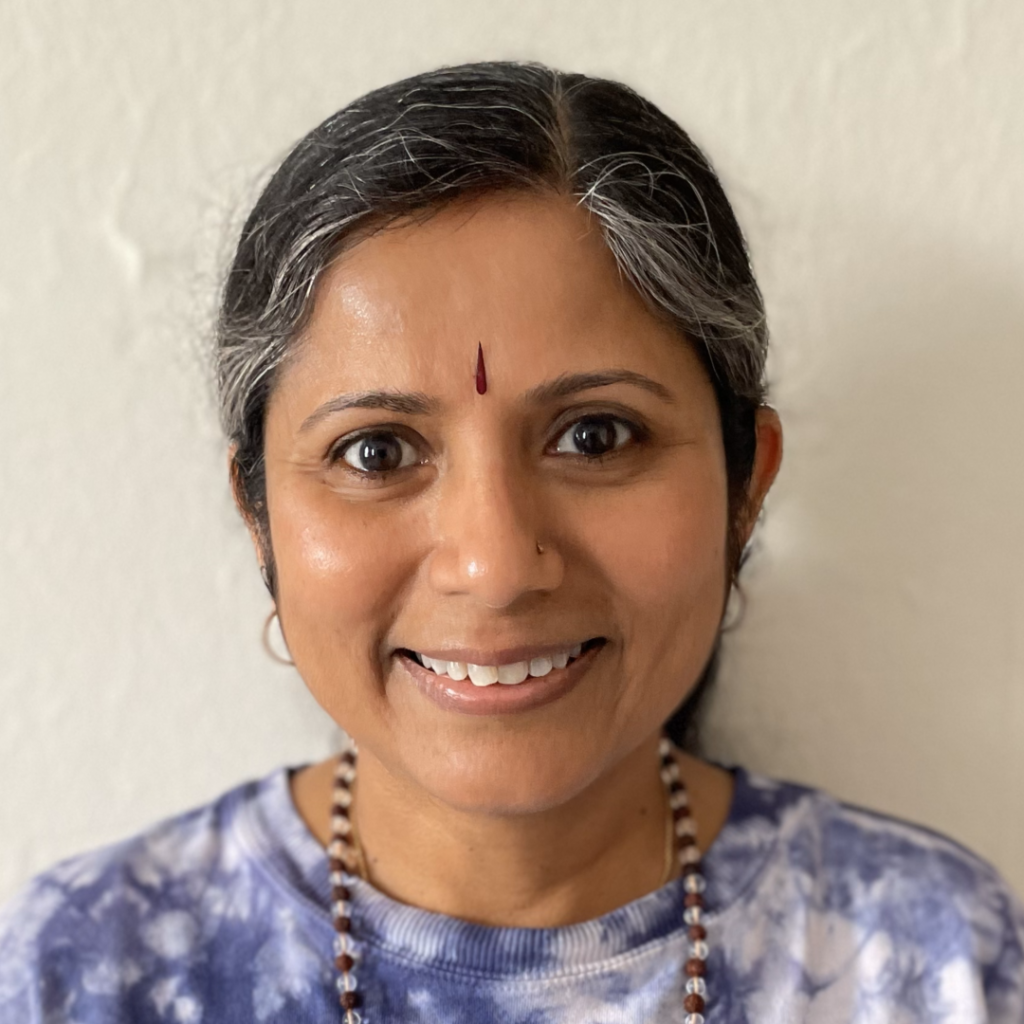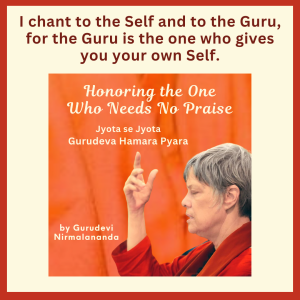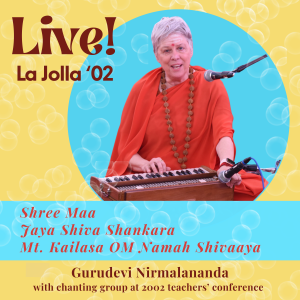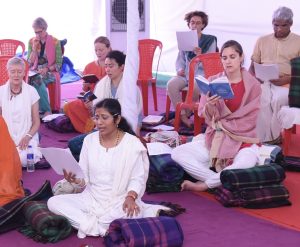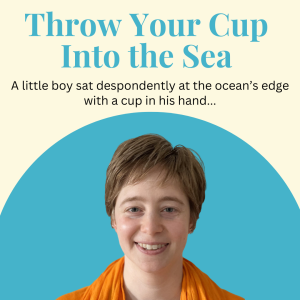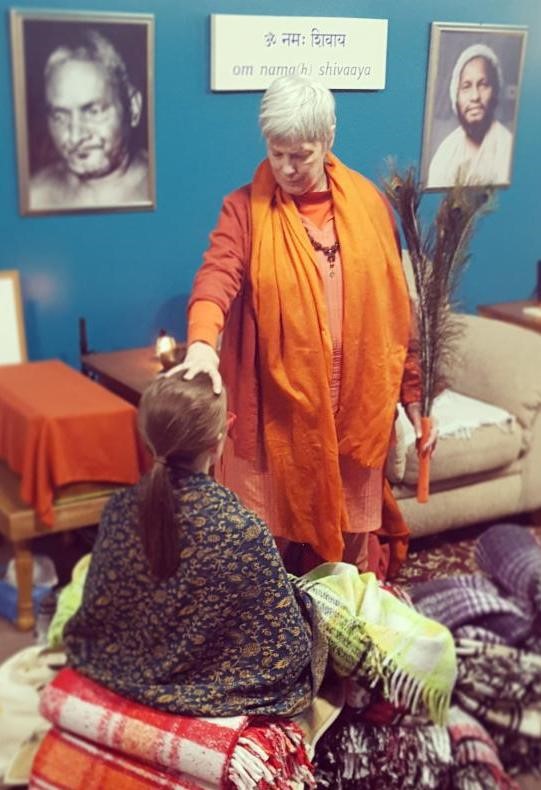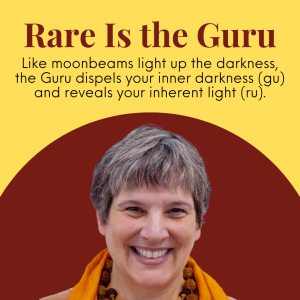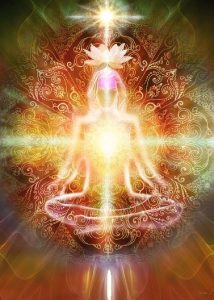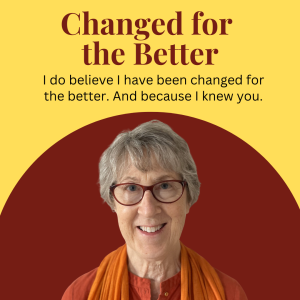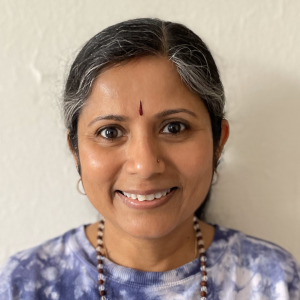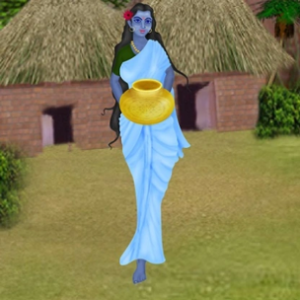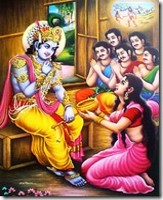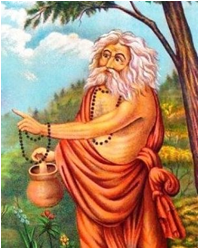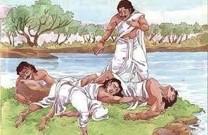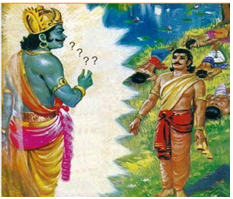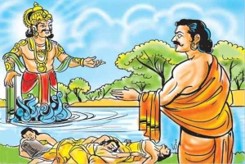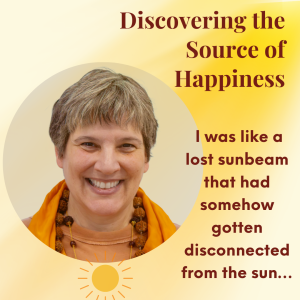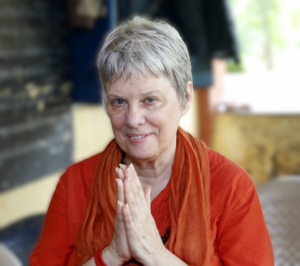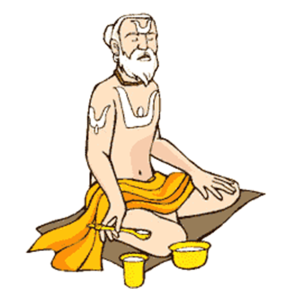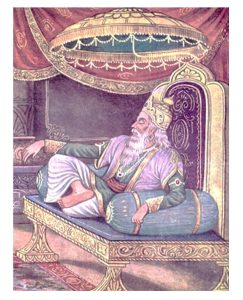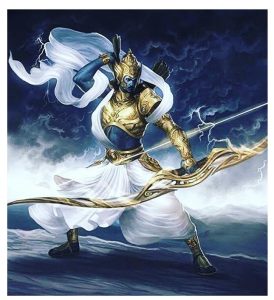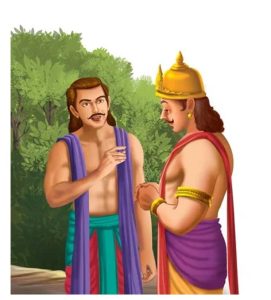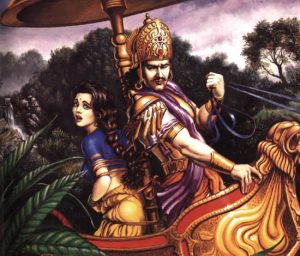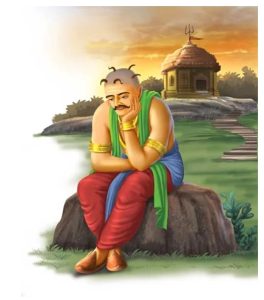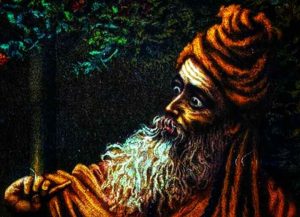By Nirooshitha Sethuram, Yogaratna
Graphics by Sheralee (Shambhavi) Hancherow
The yaksha was fully satisfied with Yudhishthira’s answers, so he asked him to choose one of his four brothers to be brought back to life.
Without a lot of thought, Yudhishthira said he chose Nakula. The yaksha was surprised by Yudhishthira’s answer and questioned him. “By picking Bhima you would have obtained strength, or by picking Arjuna you would have the greatest archer beside you. Why did you pick Nakula?”
Yudhishthira respectfully replied, “We are five brothers, sons of Kunti and Madri. Out of Mother Kunti’s three sons, I am still alive but both of Mother Madri’s sons are lying dead. I would want one of Mother Madri’s sons to live. That is the dharma for my father Pandu’s children.”
The yaksha was yet again very pleased to see Yudhishthira upholding righteousness. He said, “Oh Yudhishthira, I admire your virtuous thinking. You are a great soul. With your greatness you have conquered my heart. You have overcome all the obstacles that were put in front of you in your life. From this day onwards you shall be known as Dharmaraja. I am reviving all your brothers, for your selfless virtuous qualities.”
With this blessing, all four Pandavas came back to life. Yudhishthira was overjoyed to see his brothers alive again. He hugged them all with delight and thanked the yaksha for giving them back.
The yaksha then revealed his true form. He was none other than Yama Dharmaraja, Yudhishthira’s father, Lord of Dharma and the ever-righteous God of Death. To test Yudhishthira’s integrity, he had devised the poisoned lake, also taking the form of the stag which took the Brahmin’s churner and igniting rod.
Yama handed the churner and igniting rod over to Yudhishthira and blessed them all to successfully complete the thirteenth year of living in disguise, untraced.
He directed the Pandavas to go to the kingdom of Matsya, to be safe and untraced there for their thirteenth year incognito. The Pandavas happily returned to Draupadi and handed the churner and igniting rod over to the brahmin who was so thrilled to receive them.
It was time for the Pandavas to say goodbye to the brahmins who were living with them, to go into their thirteenth year incognito. Yudhishthira thanked them for their loyalty and full support throughout these past twelve years. He was lost for words with his heart full of gratitude and sadness for departing them. He humbly asked them for their blessings. The elder brahmin Dhaumya advised Yudhishthira to stay focused in his path of righteousness as always and blessed them to be victorious.
The prior advice from Krishna and the later advice from Yama Dharmaraja made it easy for the Pandavas to decide to go to the Matsya Kingdom. Together with Draupadi, they devised a plan to approach the king of Matsya Kingdom, Virata. He was married to Queen Sudeshna. Prince Uttara and Princess Uttaraa were their children.
The Pandavas discussed seeking various jobs to serve the king in the palace so that they would stay close to each other. They knew they neither could be seen together, nor could they do what they were good at. They had to depend on their secondary ability in order to disguise themselves well. This was very hard on Yudhishthira’s brothers. The thought of Yudhishthira , such a mighty king, especially after performing the Rajasuya Yaj~na, now going in disguise to serve another king brought tears to their eyes.
On their way to the kingdom, they dug a pit under a tree and buried all their weapons. Yudhishthira disguised himself as a brahmin named Kanka, to serve the king as an adviser. He played dice with the king and discussed politics, astrology and scriptures. He claimed that he had a good relationship with Yudhishthira. In the past twelve years, Yudhishthira had trained himself in the game of dice as he was so bad at it when he played in Hastinapura. He wanted to be ready if there was another such occasion. Therefore, it was now his second strength.
Bhima took the name Vallabha to serve as the royal cook, as he had been fond of culinary arts from his youth. To entertain the king, Vallabha occasionally participated in wrestling matches. Arjuna didn’t need a secondary ability as he became Brihannala, a eunuch serving in the queen’s palace. He taught music and dance to Princess Uttaaraa and her friends. In this way he used the curse from Urvashi to his benefit.
Nakula in the name of Dhamagranthi, training and looking after the horses in the royal stables. Sahadeva as Tantripala worked at the royal cowshed, taking care of the king’s cattle, protecting them from disease and attacks from wild animals. Draupadi as Sairandhri became Queen Sudeshna’s companion and personal maid. No one knew their true identity.
With Shakuni’s help, Duryodhana was trying to create a plan to locate the Pandava brothers during their thirteenth year. If found, the Pandavas must repeat the thirteen years all over again. This would be the ideal solution for Duryodhana, so he would not need to give the half of the kingdom to Yudhishthira after the thirteenth year.
Duryodhana sent hundreds of spies in search of the Pandavas to all the friendly kingdoms. The news from the spies did not reveal any information. Eleven months went by without any progress in getting information. Desperate, Duryodhana and Shakuni went beyond the nearby kingdoms, expanding their search in far kingdoms.
They collected information about these far kingdoms, finding that the Matsya Kingdom was going through several improvements, both in relations with their neighboring kingdoms as well as the living standards of its citizens. This made them think the Pandavas could be hiding in the Matsya Kingdom. Duryodhana and Shakuni planned a trip there.
Meanwhile, in the Matsya Kingdom, the Pandavas and Draupadi blended in very well with the royal workers. They had only one more month to go before the end of their thirteenth-year incognito. At that point, Kichaka returned to the kingdom after a long absence, having been engaged in wars with some of the kingdoms. Kichaka was Queen Sudeshna’s brother, serving as King Virata’s commander-in-chief.
Kichaka had immense influence in the kingdom. He was a great warrior and acted as if he was the king. King Virata was very weak, depending on Kichaka in many ways. One day, Kichaka came across Sairandhri at his sister’s palace. Her beauty attracted him so much that he desired to have her for himself. She said that she was married and was protected by powerful gandharvas, who would kill anyone who troubled her. Kichaka continued to harass her and pursue her, thinking that after all she was just a servant.
All his many attempts to get her failed, so he sought his sister’s help to get Sairandhri. She advised her brother against the idea. He refused to accept it and poured his heart out to her about wanting Sairandhri. Feeling sorry for her brother, Queen Sudeshna sent Sairandhri to her brother’s palace, asking her to bring some items from there for a festival that was to be held on the next day.
Seeing Sairandhri in his room made Kichaka lustful. Using the opportunity, he harassed her more forcefully. She refused him again so he attacked her. She fled to the royal court for her safety, but Kichaka followed her, abusing and kicking her in front of the king. No one dared to oppose him, but he could not go beyond that as it was in the royal court.
Distressed, Draupadi took the risk to reach out to Bhima for help. Bhima consoled her and was full of fury, ready to bring an end to Kichaka. But, remembering their situation, together they devised a plan. Bhima told her to act as if she was consenting to Kichaka’s advances and make him come to the dancing chamber in the night without anyone else knowing. Sairandhri acted as planned and asked Kichaka to come and meet her that night at the dancing chamber alone.
Kichaka was delighted to hear this and anxiously came to the chamber that night. When he entered the chamber, he saw Sairandhri waiting in the dark. He didn’t know that it was Bhima, dressed in Sairandhri’s clothes. Kichaka was too drunk to see the differences. He went close to Sairandhri to embrace her passionately. Before he realized what was going on, Bhima gave him a big blow. Kichaka was thoroughly confused. Before he could comprehend what was going on, his resistance was no match to Bhima’s aggression. Bhima killed him and left his body in the dancing chamber.
The next morning, everyone was shocked to see Kichaka murdered. When the queen asked Sairandhri about her knowledge of the incident, she told the queen and everyone else that her gandharva husband had killed Kichaka, as she had already warned.
Everyone feared Sairandhri after they learned about this. Queen Sudeshna was afraid to keep her as a maid, but Sairandhri requested to let her stay for a few more days, which would complete the thirteenth year incognito. Queen Sudeshna was too scared to refuse her request and agreed to keep her until then.
The news of Kichaka’s murder reached Duryodhana and Shakuni. Only a few people could kill Kichaka. Their suspicions increased. They were pretty sure that the Pandavas were in the Matsya Kingdom.
More to come…
1. Yaksha & Yudhishthira https://www.esamskriti.com/e/Spirituality/Philosophy/Yaksha-Prashna~-An-Encounter-between-Dharma,-the-father-and-Yudhishthira,-the-son-1.aspx
2. Yama Dharmaraja & Pandava brothers https://www.sawanonlinebookstore.com/the-yakshas-episode/
3. Map of Matsya Kingdom https://chandrasnotes.blog/2022/03/29/mahabharata-in-365-days-day-137-appointment-of-dhaumya-as-purohita-of-pandavas/
4. The Pandavas’ disguises in King Virata’s palace https://www.radiosrichinmoy.org/tales-from-the-mahabharata-the-thirteenth-year/
5. Shakuni & Duryodhana developing plan to find Pandavas https://picryl.com/media/shakuni-consolating-duryodhana-09e322
6. Kichaka https://www.quora.com/Who-was-kichak
7. Kichaka & Sairandhri https://en.wikipedia.org/wiki/Kichaka
8. Bhima kills Kichaka https://www.radiosrichinmoy.org/tales-from-the-mahabharata-the-thirteenth-year/
